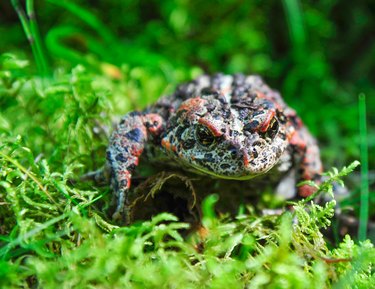There are four stages in a frog and toad's life cycle. Adult toads lay eggs that hatch into tadpoles. The tadpoles develop into froglets and finally adult toads that go on to reproduce. The length of a toad's life cycle can vary depending on the toad species. For example, the cane toad, a common toad in the Southern United States, lives five to 10 years.

Video of the Day
Frog vs. toad species
There is often some confusion about the differences between toads and frogs. Toads are a type of frog, and they have some characteristics that differentiate them from other species of frogs.
Video of the Day
Toads are poisonous, while most other species of frogs are not. This is important to remember since there can be problems if your pet attempts to eat a toad. You are also at risk if you hold a toad, as the toxin on their skin can transfer to your skin and then to your eyes and mouth.
In addition, toads tend to have shorter legs and don't hop as far as a frog can. However, a toad's life cycle is the same as a frog's life cycle.
Toad egg stage
The first of the toad life cycle stages is the egg stage. In the spring months, adult females lay eggs in the water. The eggs come out in a long chain, which is slightly different than frogs, who tend to lay eggs in a cluster or mass. The groups of eggs are called spawn. Toad eggs tend to be in deeper water than frog eggs, and the spawn tends to wrap around the plants in the water.
Toad tadpole stage
Tadpoles hatch after about one to three weeks. Toad tadpoles are black in color. By this time, they are developed enough to survive in the water and have gills and a mouth to breathe and feed. At this stage, they are confined to the water. Initially, tadpoles may continue to feed on the remaining egg yolk, but once this is gone, they feed on vegetation in the shallow water.
There are typically a large number of tadpoles in the water, as the female lays hundreds of eggs. Tadpoles are extremely vulnerable, and many are eaten by predators, such as newts, dragonflies, and fish.
Froglet and adult toads
At the froglet stage, the toad has developed legs to navigate on land and lungs to breathe air. The tail begins to shrink, but froglets still have a tail. Froglets are small and face many dangers, including snakes, foxes, and birds.
When the tail is absorbed, the toad enters adulthood, the last of the toad life cycle stages. As adults, toads are more likely to venture away from water, and they spend most of their time on land. They are carnivores and eat things like insects and slugs.
Other toad life cycle stages
Not all toads follow these toad life cycle stages. Some toads have evolved to give birth on land rather than laying eggs in the water that hatch into tadpoles. These species are more likely to be found in dry regions where water is not readily available for laying eggs.
Instead, these toads may lay eggs on land. When the eggs hatch, the toads are already in toad form rather than going through the tadpole and hatchling stages. A couple of types of toads, such as Nimbaphrynoides and Nectophrynoides toads, will keep the eggs inside their body and then give birth to live toads.